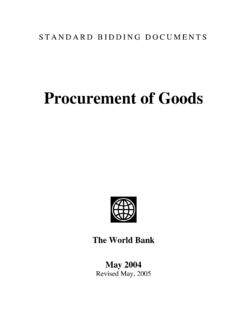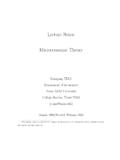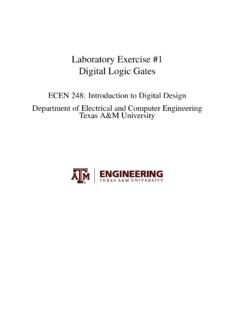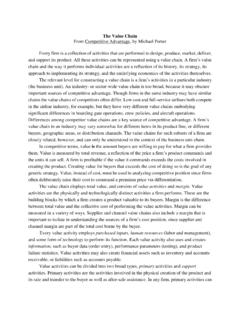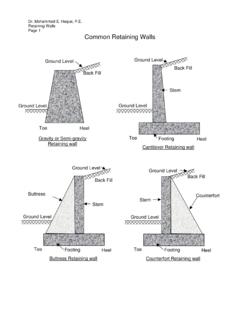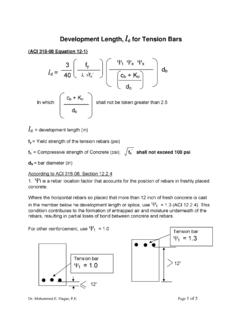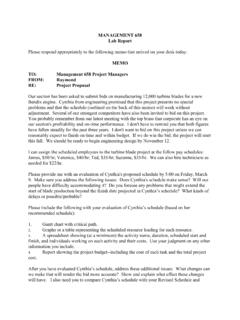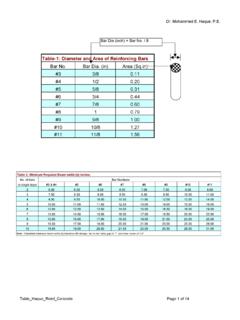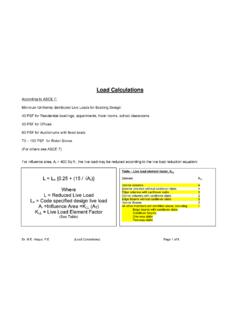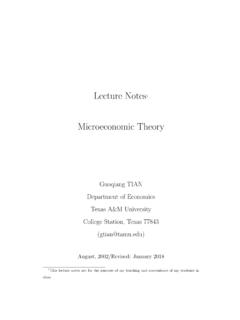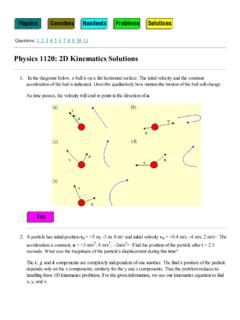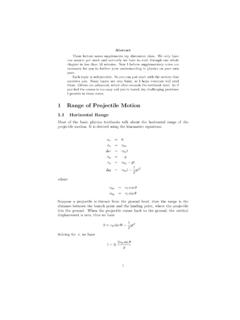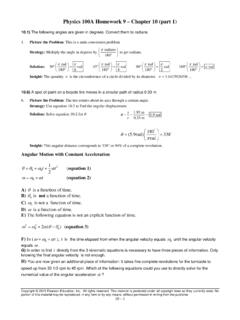Transcription of Potential Energy and Energy Conservation - Texas A&M …
1 Chapter 7. Potential Energy and Energy Conservation PowerPoint Lectures for University Physics, Twelfth Edition Hugh D. Young and Roger A. Freedman Lectures by James Pazun Copyright 2008 Pearson Education Inc., publishing as Pearson Addison-Wesley Goals for Chapter 7. To study gravitational and elastic Potential Energy (conservative forces). To determine when total mechanical Energy is conserved To examine situations when total mechanical Energy is not conserved To examine conservative forces, nonconservative forces, and the law of Energy Conservation To determine force from Potential Energy Potential Energy Things with Potential : Could do potentially do work Here we mean the same thing Gravitation Potential Energy : If you lift up a brick it has the Potential to do damage Compressed spring Example: Gravity & Potential Energy You (very slowly) lift up a brick (at rest) from the ground and then hold it at a height Z.
2 How much work has been done on the brick? How much work did you do? If you let it go, how much work will be done by gravity by the time it hits the ground? We say it has Potential Energy : U=mgZ. Gravitational Potential Energy What is the work done by the force of gravity? v0.. h The work DOES NOT depend on the trajectory!!! . Wmg Fmg ds ( mg j ) ( xi y j ). 0 ( mg )( y f yi ) UE f UEi UE=mgy=Gravitational Potential Energy Mechanical Energy We define the total mechanical Energy in a system to be the kinetic Energy plus the Potential Energy Define E K+U. Conservation of Mechanical Energy For some types of problems, Mechanical Energy is conserved (more on this next week). Mechanical Energy before you drop a brick is equal to the mechanical Energy after you drop the brick K2+U2 = K1+U1. Conservation of Mechanical Energy E2=E1.
3 Problem Solving What are the types of examples we'll encounter? Gravity Things falling Springs Converting their Potential Energy into kinetic Energy and back again Gravity: E = K + U = mv2 + mgy Spring: E = K + U = mv2 + kx2. Athletes (projectile motion ) and the Conservation of Energy If we have a projectile motion the work Energy theorem says mg(y 2 y1 ) KE 2 KE1. With some rearranging KE1 UE1 KE 2 UE 2. Energy is conserved!! Athletes and Energy II Example Refer to Figure as you follow Example Notice how velocity changes as forms of Energy interchange. Forces other than gravity doing work Consider projectile motion using energetics Consider the speed of a projectile as it traverses its parabola in the absence of air resistance. Refer to Conceptual Example and Figure Revisiting the work Energy theorem The work Energy theorem says the total work is equal to the change in KE.
4 W net KE 2 KE1. On the other hand, we have seen that the work due to gravity ONLY DEPENDS. ON THE INITIAL AND FINAL POINT OF THEIR PATH, NOT ON THE ACTUAL. PATH. These type of forces (of which gravity is one) are called conservative forces. Let's brake the total work done into two parts, the one done by the conservative forces and the ones done by non-conservative forces ( friction). W conserv W non conserv KE 2 KE1. UE 2 UE1 W non conserv KE 2 KE1. W non conserv E 2 E1 where E KE UE. If the work done by the non-conservative forces is zero then the total Energy is conserved. This is a very powerful tool!! Box on an inclined plane A box with mass m is placed on a frictionless incline with angle and is allowed to slide down. a) What is the normal force? b) What is the acceleration of the box? c) What is the velocity at the end of the ramp with length L?
5 FN. mg cos . wB=mg . mg sin . x : mgsin max ax gsin . y : FN mgcos 0. Box on an inclined plane REVISITED. A box with mass m is placed on a frictionless incline with angle and is allowed to slide down. a) What is the velocity at the end of the ramp with length L? FN.. wB=mg Normal force DOES NO WORK so Wother=0. Then Etop=Ebottom KE top UE top KE bott UE bott 1. 0 mgh m v 2 0. 2 v 2gL sin . 1. mgL sin m v 2. 2. What's the speed in a vertical circle? Refer to Example and Figure KE top UE top KE bott UE bott 1. 0 mgh m v 2 0. 2 v 2gR. 1. mgR m v 2. 2. Speed in a vertical circle with friction Consider how things change when friction is introduced. Refer to Example and Figure Work and Energy in the motion of a mass on a spring x2. W spring ( kx )dx kx 2 kx1. 1 2 1 2. x1 2 2. UE spring 2 UE spring1. Work Energy theorem: situations with both gravitational and elastic Potential Energy W conserv W non conserv KE 2 KE1.
6 UE grav 2 UE grav 1 UE spring 2 UE spring 1 W non conserv KE 2 KE1. W non conserv E 2 E1 where 1 1 2. E KE UE grav UE spring m v mgy kx 2. 2 2. motion with elastic Potential Energy Example Bring together two Potential energies and friction Example What is the spring constant needed? W non conserv E 2 E1. W non conserv F f s (17,000N)(2m). 1 1. E1 m v12 mgy1 kx12 . 2 2. 1. (2000kg)(4 m/s) 2 (2000kg)g(2m) 0. 2. 1 1. E 2 m v 2 2 mgy 2 kx 2 2 . 2 2. 1. 0 0 k(2m) 2. 2. 34000 2k 55200. k 10 4 N/m Friction does depend on the path taken Consider Example where the nonconservative frictional force changes with path. Relation between Potential Energy and force r r W cons Fcons ds UE. r r dW cons Fcons ds dUE. r dUE. Fcons r ds dUE dUE dUE. Fcons x Fcons y Fcons z . dx dy dz For example. For gravity d( mgy ). Fgrav y mg dy For example.
7 For gravity 1 2. d( kx ). Fspring x 2 kx dx This is the end of Ch 7. Let's next review briefly the main concepts so far and then do more examples CH1-3: kinematics : equations of motion CH 4-5: Newton's laws of motion rNewton's 3r law rd For constant coordinate system Time of flight, rotation, etc. IF you know acceleration then all motion follows F x max ; Fy may ; Fz maz F on A by B Fon B by A. General understanding of acceleration: Acceleration They are the ones from which you find the acceleration of component along/against velocity vector objects (connection to Ch. 1-3). increases/decreases speed; perpendicular acceleration Steps: (1) draw sketch, (2) draw all forces and label 3rd law pairs, component changes direction (left or right). IF particle is (3) draw free body diagram for each object, (4) choose going along a circle the radial component is equal to v2/r coordinates for each object (if circular motion there is no choice, (due to geometry, otherwise it spirals in or out).)
8 One has to be radial positive towards center- and the other r r r dv r dr r tangential), (5) decompose forces that are not along axis chosen, a v r x(t)i y(t) j z(t) k . dt dt (6) write Newt. 2nd law for EACH object, (7) are there relations Constant acceleration among objects ( same velocity, or one twice the other, etc.), 1 (8) how many equations and how many unknowns. NOW you are Constant velocity x x 0 v 0x t ax t 2. 2 ready to solve for the question this is a good time to look back at x x 0 vx t v x v 0x ax t the question. Force of friction: know distinction between static (no v x 2 v 0x 2 2ax (x x 0 ) acceleration) and kinetic (there is motion relative to the surface). Projectile motion : Circular motion : if moving along a circle sum of forces along the x-comp. is constant velocity radial direction MUST add to mv2/r y-comp.
9 Is constant acceleration Coordinate system 2. is NOT constant, it rotates!! F ; Ftan matan ; Fz maz v r m R. CH 6-7: Work and Energy general constant force r r r r r r . r2. Work done by a force is W by F r F dr F ( r2 r1 ) F r cos F r r1. Work Energy theorem (also contains Conservation of Energy ). W non conserv E 2 E1. 1 1. E KE UE grav UE spring m v 2 mgy kx 2. 2 2. Math that I should know VERY WELL by now Algebra (solve ANY complicated equation and pairs of equations). Derivatives (what they mean, know how to use them to find maximums/minim.). Scalar products of vectors (use them to calculate work, angles, etc.). Basic integrals (calculate work of changing forces, complicated equations of motion ). Problem Conservation of Energy : gravity and spring A kg block is pushed against a spring with negligible mass and force constant k = 400 N/m, compressing it m.
10 When the block is released, it moves along a frictionless, horizontal surface and then up a frictionless incline with slope degrees. (a) What is the speed of the block as it slides along the horizontal surface after having left the spring? (b) How far does the block travel up the incline before starting to slide back down? C. L Both of these are Conservation of Energy (a) EA EB. 1 1 1 1. m v A 2 mgy A kx A2 m v B 2 mgy B kx B2. 2 2 2 2. A B 1 1. 0 0 kx A2 m v B 2 0 0. 2 2. EA EB. (b) kx A2. 1 1 1 1. m v A 2 mgy A kx A2 m vC 2 mgyC kxC2 vB. 2 2 2 2 m 1. 0 0 kx A2 0 mgyC 0. 2. 1 kx A2. yC L sin . 2 mg 1 kx A2. L. 2 mgsin . NOW A PULLEY PROBLEM. Problem Pulley problem What is the speed of the larger block before it strikes the ground? TWO CHOICES: CH 4-5 style or CH 6-7 style Because there is no friction then Energy is conserved EA EB.
